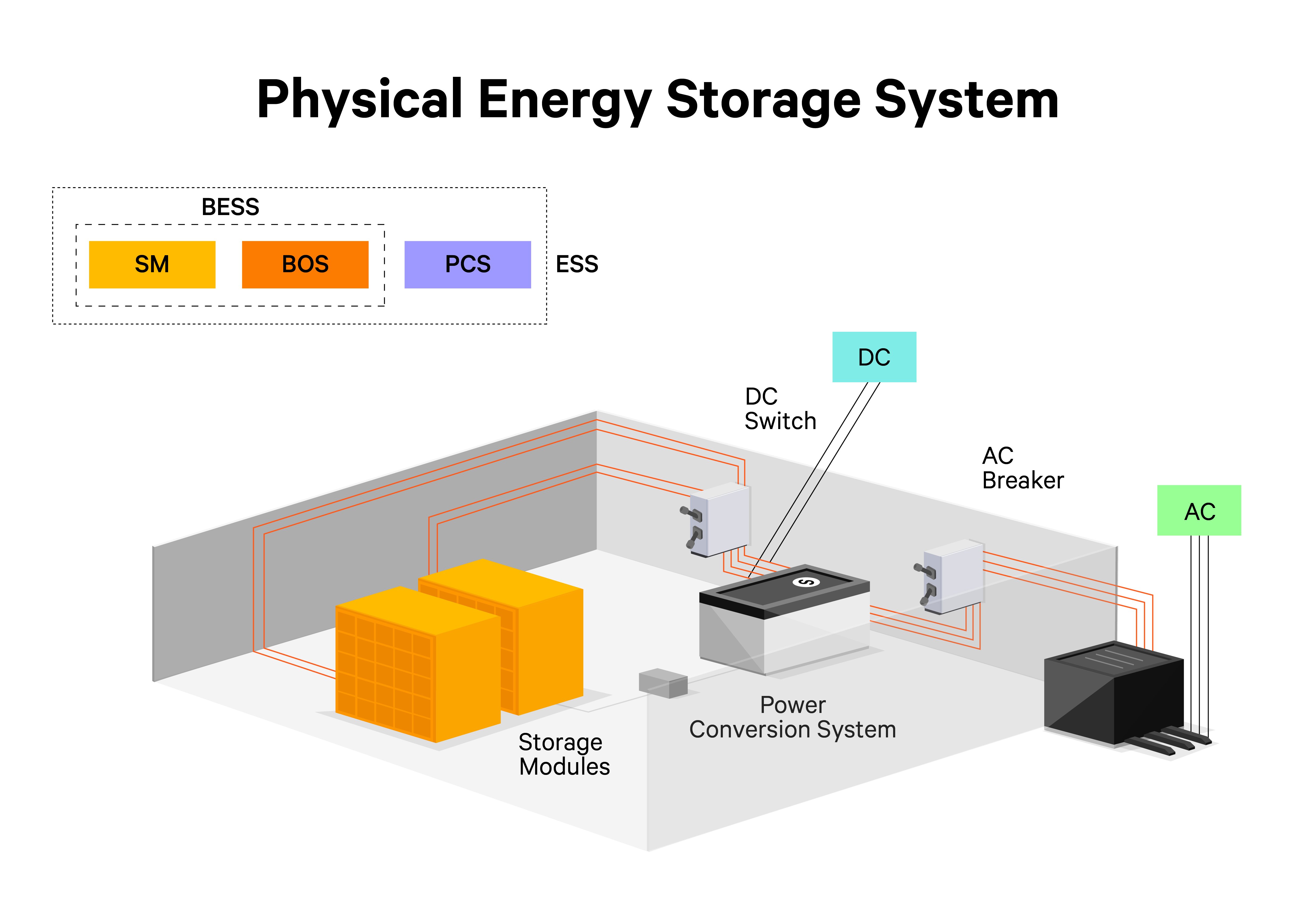News
PALMA SOLUTIONS JSC
Components and Operating Principles of Battery Energy Storage Systems (BESS)
In the previous two articles, we explored the concept of Battery Energy Storage Systems (BESS) and their role in balancing energy supply and demand, supporting renewable energy integration, and contributing to the Net Zero target.
Continuing this series, the following article delves deeper into the structure and operating mechanism of a modern BESS system, which plays a crucial role in ensuring efficiency, safety, and sustainability in energy management.
1. General Operating Principles of BESS
A Battery Energy Storage System (BESS) operates based on a controlled charge–discharge mechanism, allowing it to store excess energy and supply it back when needed.
Individual battery cells are assembled into modules, which are then interconnected into strings to achieve the desired direct current (DC) voltage. The DC output is routed to a Power Conversion System (PCS) that converts it into alternating current (AC) for end-use applications or grid integration.
The charging and discharging process works bidirectionally:
- When renewable energy sources produce excess electricity (for example, solar power during the day), the BESS charges the batteries.
- When energy demand increases or the main power source declines, the BESS discharges stored energy back into the system, ensuring a stable and continuous supply.
This mechanism enables BESS to act as an intelligent bridge between renewable energy generation and actual consumption, contributing to grid reliability and flexibility.
2. Main Components of a BESS
To operate effectively, a BESS consists of multiple subsystems that function in harmony, each serving a specific role:
- Battery Cells: The core components that directly store electrical energy.
- Modules and Strings: Assemblies of battery cells connected to reach the required capacity and voltage.
- Power Conversion System (PCS/Inverter): Converts DC to AC and vice versa, enabling flexible connection between the BESS and the grid or loads.
- Battery Management System (BMS): Monitors the charge level, temperature, and voltage of each cell to prevent failures and optimize lifespan.
- Thermal Management System: Maintains stable operating temperatures to avoid overheating and performance degradation.
- Energy Management System (EMS): Coordinates the overall charge–discharge activities of the system, optimizing operation according to demand and electricity prices.
- Grid Controller: Manages the flow of electricity between the BESS and the power grid, maintaining voltage and frequency stability.

Figure 1. Main components of a Battery Energy Storage System (BESS)
(source from Vertiv).
The precise coordination between these subsystems ensures safe, reliable, and efficient operation of BESS across various scales — from residential to industrial and utility-scale applications.
3. Common Battery Technologies in BESS
Depending on specific applications and capacity requirements, BESS solutions can integrate different battery technologies, including:
- Lithium-ion: High energy density, excellent efficiency, and long lifespan — the most widely used battery type today.
- Lithium Iron Phosphate (LFP): A safer variant of lithium-ion with higher thermal stability and long cycle life.
- Lead-acid: A cost-effective traditional option, though limited in efficiency and lifespan.
- Flow Batteries: Utilize liquid electrolytes, enabling scalability and extended service life — suitable for large-scale storage.
- Sodium–Sulfur (NaS): High-temperature batteries with high energy density, commonly used for fixed large-capacity systems.
Among these, LFP batteries are increasingly favored for their safety, durability, and recyclability, making them ideal for modern energy storage projects.
4. Operational Efficiency and Real-World Applications
A modern BESS not only stores energy but also functions as an intelligent energy management solution, offering multiple operational and economic benefits:
- Peak Shaving: Charging during off-peak hours and discharging during peak hours to reduce electricity costs.
- Renewable Energy Stabilization: Storing surplus solar or wind energy and supplying it when generation fluctuates.
- Optimized Generator Operation: Reducing generator start-ups, improving fuel efficiency, and extending equipment lifespan.
- Enhanced Grid Reliability: Minimizing voltage fluctuations and ensuring continuous, high-quality power supply for industrial parks, data centers, and critical facilities.
Through its flexibility and scalability, BESS has become a cornerstone technology in smart grids and distributed energy systems.
5. Lifespan, Second Life, and Sustainable Value of BESS
Typically, a Battery Energy Storage System has an average lifespan of 5 to 15 years, depending on the battery chemistry, charge–discharge cycles, and operating conditions. However, the value of BESS extends beyond its first life.
When battery cells can no longer meet the performance requirements for large-scale storage, they can still be repurposed for secondary applications, such as residential backup systems or smaller electrical devices.
At the end of their usable life, battery recycling enables the recovery of valuable materials like lithium, nickel, cobalt, and copper — reducing the need for new mining activities, minimizing waste, and supporting the circular economy.
This process not only generates environmental benefits but also delivers economic advantages, as reusing and recycling batteries help lower waste management costs and enhance resource efficiency.
Ultimately, the design, operation, and lifecycle management of BESS make it an essential enabler for flexible, reliable, and sustainable power systems, directly contributing to the global Net Zero transition and a cleaner energy future.
10/10/2025 13:46:52
News other
Explore the components, operating principles, battery technologies, and sustainable lifecycle of Battery Energy Storage Systems (BESS) – a key solution toward Net Zero.
Battery Energy Storage Systems (BESS) help Vietnam optimize renewable energy, stabilize the power grid, and accelerate the clean energy transition.
 PALMA SOLUTIONS JSC
PALMA SOLUTIONS JSC







![[PALMA x NOVALAND] WORKSHOP ON MAINTENANCE AND SERVICING OF SOLAR LANDSCAPE LIGHT PLL-30 AT NOVA HILLS – MUI NE [PALMA x NOVALAND] WORKSHOP ON MAINTENANCE AND SERVICING OF SOLAR LANDSCAPE LIGHT PLL-30 AT NOVA HILLS – MUI NE](https://www.palma.com.vn/upload/z3634653067260_15cb1f4d62b14f3a684fdf4ee9de4870_-11-08-2022-13-55-36.jpg)
_-10-12-2025-00-33-27.jpg)

_-24-10-2021-21-55-01.png)
_-21-04-2022-13-38-01.png)
